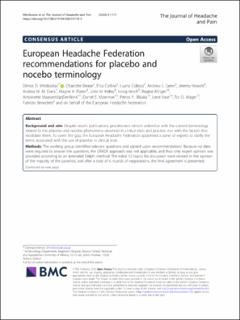| dc.description.abstract | Background and aim
Despite recent publications, practitioners remain unfamiliar with the current terminology related to the placebo and nocebo phenomena observed in clinical trials and practice, nor with the factors that modulate them. To cover the gap, the European Headache Federation appointed a panel of experts to clarify the terms associated with the use of placebo in clinical trials.
Methods
The working group identified relevant questions and agreed upon recommendations. Because no data were required to answer the questions, the GRADE approach was not applicable, and thus only expert opinion was provided according to an amended Delphi method. The initial 12 topics for discussion were revised in the opinion of the majority of the panelists, and after a total of 6 rounds of negotiations, the final agreement is presented.
Results/recommendations
Two primary and mechanism-based recommendations are provided for the results of clinical trials: [1] to distinguish the placebo or nocebo response from the placebo or nocebo effect; and [2] for any favorable outcome observed after placebo administration, the term “placebo response” should be used, and for any unfavorable outcome recorded after placebo administration, the term “nocebo response” should be used (12 out of 17 panelists agreed, 70.6% agreement). The placebo or nocebo responses are attributed to a set of factors including those that are related to the medical condition (e.g. natural history, random comorbidities, etc.), along with idiosyncratic ones, in which the placebo or nocebo effects are attributed to idiosyncratic, or nonspecific mechanisms, exclusively (e.g. expectation, conditioning, observational learning etc.). To help investigators and practitioners, the panel summarized a list of environmental factors and idiosyncratic dynamics modulating placebo and nocebo effects. Some of them are modifiable, and investigators or physicians need to know about them in order to modify these factors appropriately to improve treatment. One secondary recommendation addresses the use of the terms “placebo” and “nocebo” (“placebos” and “nocebos” in plural), which refer to the triggers of the placebo/nocebo effects or responses, respectively, and which are inert agents or interventions that should not be confused with the placebo/nocebo responses or effects themselves (all panelists agreed, 100% agreement).
Conclusion
The working group recommends distinguishing the term response from effect to describe health changes from before to after placebo application and to distinguish the terms placebo(s) or nocebo(s) from the health consequences that they cause (placebo/nocebo responses or effects). | en_US |

